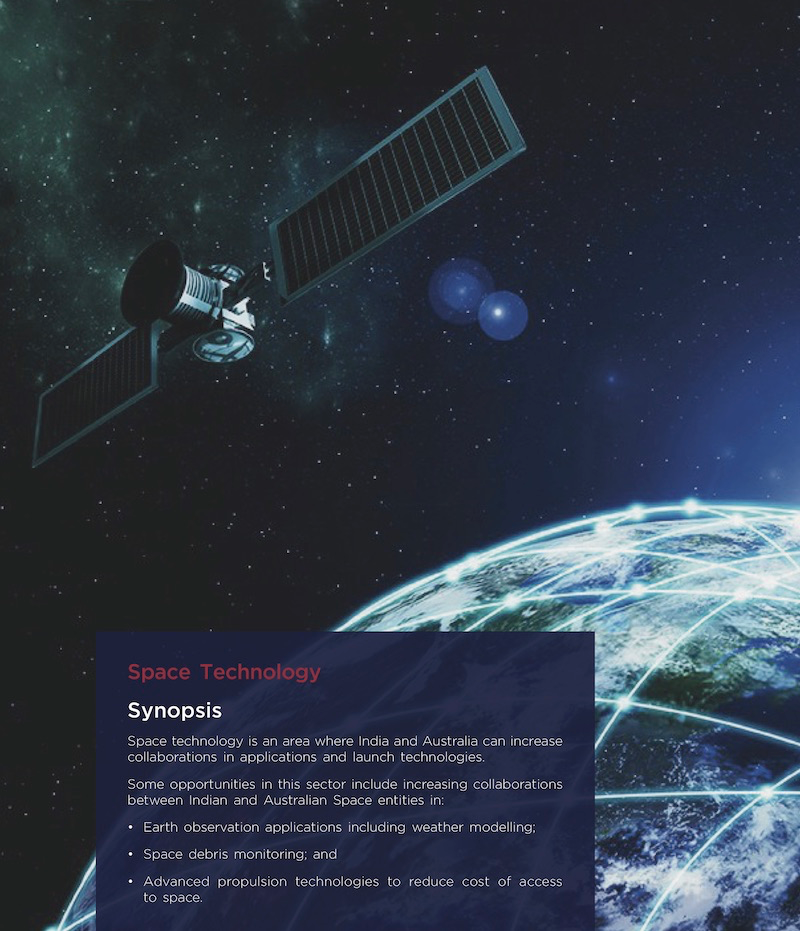Emerging Sectors
Space Technology

Indian space missions under the ambit of India’s space agency, Indian Space Research Organisation (ISRO), have been highly successful in recent years. Since its formation in 1969, ISRO has undertaken a large number of spacecraft missions, which include communication satellites, earth observation satellites, space exploration satellites and navigation satellites.
From launching small rockets with only 30-40 kg payload to the transport of 4,000 kg payload into space, ISRO has achieved significant progress in space technology. As of November 2018, India had the 7th largest number of satellites in space. India has succeeded in its maiden attempt to put a satellite in the Mars orbit.

The Indian Government spend on space programs has been on the rise, from USD 588.1 million in 2009-10 to USD 16,301 million in 2018-19. The increased spend has been on account of an improved push on capital expenditure. Revenue expenditure on space research grew by 27% from 2014-15 to 2018-19, while capital expenditure quadrupled in the same period496.
Some upcoming space missions by ISRO include the organization’s ambitious manned mission, Gaganyaan in 2022, science missions like Aditya L-1, India’s first solar mission and interplanetary missions to Mars and Venus497.
Since outcomes in this sector are dependent on complementary information from multiple sensors on ground and in space, space technology benefits immensely from international partnerships. In the past, India has successfully collaborated with its international counterparts
such as NASA, ROSCOSMOS, CNES, the European Space Agency, Canadian Space Agency (CSA) etc. Chandrayaan-1, India’s maiden mission to the moon, was one such example of international collaboration, wherein it carried six scientific payloads from other countries. This mission has helped NASA and ISRO to jointly discover presence of water molecules on the moon’s surface498.
Australia launched an independent space agency, Australian Space Agency (ASA), in 2018. Australia has developed expertise in communications technologies, hosting ground stations for space missions; Space Situational Awareness (SSA) and debris monitoring; Positioning, Navigation and Timing (PNT) infrastructure; and Earth Observation (EO) services.
India and Australia already have an MoU for space cooperation which provides scope for cooperation in many areas. ISRO and Geosciences Australia (GA) have also signed Implementing Arrangements for cooperation in earth observation and satellite navigation. India has also
collaborated with Australia’s private companies operating in the sector. Indian PSLV has bagged its first order from Australia.
There are ample opportunities for joint space collaborations between the two countries. The Australian Space agency and ISRO can potentially collaborate on several missions that could include oceanography and remote sensing in the Indian Ocean region. Given that both the
countries are reeling from effects of climate change, collaborations on satellite missions for mapping weather systems, analysis of cropping pattern, sea surface temperatures, ocean currents can also prove to be mutually beneficial.
Recognizing the potential and each other’s capabilities, both agencies have identified the following areas for cooperation:
- Space Situational Awareness (SSA) activities.
- Calibration and Validation of Satellite data.
- Sharing of Meteorology and Oceanographic data for weather modelling.
- Establishment of Ground stations in Australia for Navigation, ranging and satellite missions.
Australia has cooperated with the US for demonstrating scramjet flights using rocket engines. India has also demonstrated its capabilities in air breathing scramjet engine propulsion technology, which will be the future technology for low cost access to space. Hence, there is potential for Indian and Australian space entities to collaborate on the development of air
breathing propulsion technologies for reusable rocket engines and reusable suborbital rocket systems, which will have good commercial potential.
ISRO has forged a strong relationship with many Indian industrial enterprises, both in the public and private sectors, to implement its space projects. With ISRO undertaking the production of cutting-edge technologies for its missions through Indian industries, there is a tremendous scope of leveraging the industry expertise for establishing global production hubs of space in other countries including Australia. The commercial wings of space like NewSpace India Limited (NSIL) and Antrix can expand their base for the global marketing of space products
and services through a partnership with Australian space entities.
In the face of the ongoing COVID-19 pandemic, several reforms were announced by India’s Finance Minister to revive the Indian economy in mid-May 2020. The Government of India will offer level playing field for private companies in satellite launches and other space-based
services. Furthermore, private companies will be permitted to use ISRO facilities to improve their own respective capacities. Liberal geospatial data policy will further offer remote sensing data to technology-based entrepreneurs. Private companies can thus participate in the Space
Sector in India and increase collaborations with Australian companies.
Recommendations
- Encouraging collaborations between Australian Space Agency and ISRO in areas of mutual interest to both countries such as oceanography and remote sensing in the Indian Ocean region.
- Encouraging R&D and manufacturing collaborations between Indian and Australian space agencies to develop technologies such as air breathing propulsion systems for reusable rocket engines and reusable suborbital rocket systems.
496 Mission Shakti: India’s space research spending triples to Rs 11,538 crore, 2019, Business Standard
497 Chandrayaan-2 will have no impact on future missions: ISRO, 2019, Livemint
498 International Cooperation; ISRO
Next topic: